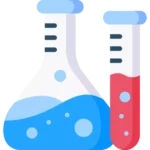Guess paper Chemistry Class 11 is up-to-date and the most important questions are given according to Punjab boards. These Guess Papers will help you to get the highest marks in your papers. Punjab Board Guess Paper Chemistry is relevant to all chapters, and we have tried to include all the necessary questions to help students score more than seventy percent.
11th Class Chemistry Guess Paper by Ahsa.Pk is available, and you may ask if you need any assistance from our qualified team. Chemistry Class 11 guess papers are for helping material that may enhance the student’s chances of getting more marks in less time.
Guess Paper Chemistry Class 11
11th Class Chemistry Important Short Questions
Chapter 1
- How N2 and CO have the same number of electrons, protons, and neutrons?
- No individual neon atom in the sample of an element has a mass of 20.18 amu. Justify.
- Atomic masses are in fractions. Justify.
- How limiting reactant controls the amount of product formed?
- 32 g and O2, 28 g of N2, and 16 g of CH4 have different masses and same volume. Why?
- Why actual yield is lesser than the theoretical yield?
- Law of conservation of mass has to be obeyed during stoichiometric calculations. Explain.
- One mole of H2SO4 should completely react with two moles of NaOH. How does Avogadro’s number help us to explain it?
- Calculate the mass of 5.136 moles of Ag2CO3.
- What are molecular ions? How they are formed. Give their applications.
- How the efficiency of the chemical reaction is determined?
Chapter 2
- Why NaCl cannot be purified by crystallization?
- How crystals are dried? Vacuum Desiccator is a safe and reliable method of drying crystals.
- How colored impurities are removed from crystals during crystallization?
- Give uses of chromatography.
- Differentiate between adsorption and partition chromatography.
- Define sublimation with an example.
- Why concentrated HCl and KMnO4 cannot be filtered by the Gooch crucible?
- Repeated extractions using small portions of solvent are more efficient than using a single extraction. Why?
Chapter 3
- Gases behave ideally at low pressure and high temperature. Explain.
- Calculate the value of ‘R’ SI units.
- Water vapours do not behave at 273K. Why?
- What is the significance of Van der Waals constants?
- Differentiate between effusion and diffusion.
- Do you think that some of the postulates of kinetic molecular theory are faulty? Point out these postulates.
- Differentiate between artificial and natural plasma.
- Explain the application of Dalton’s law in respiration.
Chapter 4
- Why there is a big difference in the physical states of halogens as we move from fluorine to iodine?
- Food is cooked quickly in the pressure cooker. Why?
- Why one feel sense of cooling under the fan after the bath?
- Boiling needs a constant supply of heat. Explain.
- Diamond is hard and electrically neutral. Explain.
- Why graphite is conductor parallel to its layers, not perpendicular?
- Cleavage itself is an anisotropic property. How?
- Why ionic crystals are highly brittle?
Chapter 5
- Why positive rays are also called ‘canal rays’?
- Why do you come to know that velocities of electrons in orbits closer to the nucleus are higher than those in higher orbits?
- Differentiate between atomic emission and atomic absorption spectrum.
- What is Zeeman effect?
- What is stark effect?
- Why the e/m value of cathode rays is just equal to electrons?
- State Pauli’s exclusion principle.
- Differentiate between continuous and line spectrum.
- Justify that distance gaps between different orbits go on increasing from the lower to the higher orbits.
- Write two properties of neutrons.
Chapter 6
- Bond distance is the compromise distance between two atoms. Justify.
- Why 2nd ionization energy always greater than first ionization energy?
- No bond in chemistry is 100% ionic.
- Why the energy of the molecular orbitals is lesser than anti-bonding molecular orbits?
- Ionic bonds are non-directional. Justify.
- Define dipole moment.
- What is the limitation of VSEPR theory?
- The ionization energy of group II-A is higher than group III-A. Why?
- Why oxygen is paramagnetic in nature?
- Sigma bond is stronger than Pi bond. Explain.
- Pi-bonds are more diffused than sigma bonds. Explain.
- The dipole moment of CO2 and CS2 are zero, but that of SO2 is 1.61D. Why?
Chapter 7
- Explain the burning of a candle is a spontaneous process.
- Define enthalpy of neutralization with an example.
- State first law of thermodynamics.
- Volume is a state function. Justify.
- Define enthalpy of atomization with an example.
- Define enthalpy of solution.
- Differentiate between spontaneous and non-spontaneous reactions.
- State Born Haber cycle.
Chapter 8
- The solubility of glucose in water is increased by increasing the temperature. Explain.
- How the direction of a reaction can be predicted by the equilibrium constant?
- Define pH and pOH.
- What is ionic product of water?
- Solubilities are depressed by the addition of common ions.
- State Le-Chatlier’s principle.
- What is solubility product? What is solubility product expression for PbCl2?
- Define buffer capacity.
- High pressure favours the reaction in which there is decrease in volume (reactants to products).
- What are acidic buffers? Give an example.
Chapter 9
- One molal solution is more dilute than one molar solution. Explain.
- Define parts per million.
- The sum of mole fractions of all components is unity. Justify.
- Why the vapor pressure of solution is less than that of pure solvent?
- State Raoult’s law.
- NaCl and KCl are used to lower the melting point of ice. Justify.
- Molality is independent of temperature but molarity depends upon temperature. Why?
- What are Zeotropes? Give example.
- Define the Colligative properties. Name any two Colligative properties.
- Beckmann’s thermometer is used to note the depression in freezing point. Why?
Chapter 10
- What is the function of salt bridge in voltaic cell?
- How sodium metal is prepared by Down’s cell?
- Calculate the oxidation number of chromium in (a) CrCl3 (b) K2Cr2O7
- How impure copper can be purified by electrolysis?
- A salt bridge maintains electrical neutrality. How?
- How electrochemical series helps us to determine whether the reaction is feasible or not?
- Na and K can displace hydrogen from acids but Pt, Pd, and Cu cannot. Why?
- Lead accumulator is rechargeable. Explain.
- Write down the reactions happening in fuel cells.
- Write down the advantages of fuel cells over other batteries.
Chapter 11
- Define reaction kinetics.
- Rate of reaction is an ever-changing parameter. Justify.
- Radioactive decay is always first-order reaction. Justify.
- Photochemical reactions are usually zero-order reactions. Explain.
- How half-life of a chemical reaction is related to the initial concentration of reactants?
- How order is determined by the method of large excess?
- How surface area affects the rate of a chemical reaction. Give an example.
- How rate is affected by light?
- Differentiate between homogeneous and heterogeneous catalysis.
- A catalyst does not affect the equilibrium constant. Justify.
- A catalyst is specific in nature. Justify.
- Define catalytic poisoning.
- What is negative catalyst? Give example.
- What is auto catalyst? Give example.
- Give two characteristics of enzyme catalysis.
Click Here for 1st Year Chemistry MCQs
11th Class Chemistry Important Long Questions
- What is Dalton’s law of partial pressure? Also, discuss its application.
- One mole of methane is maintained at 300 K. Its volume is 250 cm3. Calculate the pressure exerted by the gas when it is considered an ideal gas.
- Calculate the mass of 1 dm3 of NH3 gas at 30oC and 100 mmHg pressure, considering the NH3 is behaving ideally.
- Give eight postulates of kinetic molecular theory.
- What is H-bonding? Discuss H-bonding in biological compounds.
- How does hydrogen bonding explain the formation of ice with lesser density than liquid water?
- Define liquid crystals. Discuss important uses of liquid crystal.
- Write down the properties of ionic solids.
- Explain Rutherford’s model of the atom. Give its defects.
- Define Quantum numbers. Discuss briefly the Azimuthal Quantum number.
- Give the different postulates of Bohr’s atomic model.
- Write down the main postulates of valence shell electron pair repulsion theory and discuss the structure of NH3 with reference to this theory.
- Briefly explain the shapes of NH3 and H2O molecules according to hybridizing theory.
- Why bond formation is not possible between two He atoms? Prove with molecular orbital theory.
- Describe the bomb Calorimeter.
- Define and explain Hess’s law of constant heat summation with examples.
- Define the following terms: Molality, Mole fraction, and part per million.
- What is Raoul’s law? Give its three statements.
- Describe one method to determine the boiling point of elevation of solutes.
- State rules for assigning oxidation number of elements with examples.
- Write construction and working of a voltaic cell.
- Describe the electrolysis of molten sodium chloride and a concentrated solution of sodium chloride.
- Give four industrial importance of the electrolysis process in detail.
- What is electrochemical series? Give its four applications.
- How light and surface are affecting the rate of reaction.
- Write four characteristics of a catalyst.
- How does the Arrhenius equation help us to calculate the energy of activation of the reaction?
- Define the Half-Life period and order of the reaction. Describe the half-life method to determine the order or reaction.






